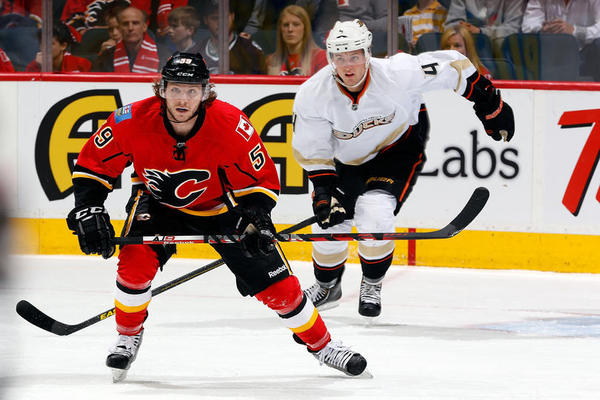The 2014 Flames Fifteen – #10: Max Reinhart
9 years ago

Via the NHL
Last year, Kent ended Max Reinhart’s NHLE analysis like this:
Max Reinhart might get some leeway as a 20-year old pro rookie, but he’ll have to make huge strides as a sophomore to start looking like he’s worth a damn.
Guess what? He did.
The Flames’ first pick in the 2010 NHL Draft (64th overall) comes in at 10 on our countdown.
Don’t look at a ranking this “low” and think that we’re down on Reinhart as a prospect. True, he did rank higher in both of the past two Flames Fifteens – but I’m fairly certain everyone on this site expects Reinhart to be an NHLer. (You’ll see why in a couple grafs.) He hasn’t taken a step backwards, as a cursory glance of this article might suggest. Reinhart just finished up one of the most prolific seasons for a Flames prospect at the AHL level since Theo Fleury, leading the Abbotsford Heat in scoring (21+42 in 66 GP) and finishing 12th overall in the AHL.
| Justin | Kent | Ryan | BoL | Byron | Taylor | Christian | 2013 | 2012 | |
|---|---|---|---|---|---|---|---|---|---|
| Max Reinhart | 9 | 6 | 11 | 11 | 10 | 9 | 11 | 5 | 4 |
Reinhart increased his scoring substantially year-over-year, as he moved up to the second line to start the year and finished up on the first line. Reinhart had some pretty good seasons NHLE-wise in the WHL, scoring 17 in his draft season, 27 in his +1 and 33 in his final year in the ‘Dub. That’s good progression. He hit a bit of a snag last year, though, playing tough PK minutes and skating with PL3 from time to time – dropping his NHLE to just 14. However, he averaged 2.1 shots per game, which was a positive sign. I can’t figure out his true on-ice SH%, but I’m going to guess it was below average like his personal SH% (4.9%), which explains a little of the low production.
Reinhart got the benefit of good luck (or the benefit of not having bad luck) this year, though, shooting 12.7% and getting to play with better linemates. Abbotsford was a pretty lucky team this year, but most of that was due more to the SV% than the SH%, meaning Reinhart’s assist totals probably aren’t inflated too much – although Abbotsford did probably score more than they should have, so who knows.
| Power Play Points | Secondary Assists | Team Scoring | |
|---|---|---|---|
| Max Reinhart | 33% (21/62) | 41% (17/42) | 27% (63/237) |
His secondary assist percentage was roughly average, but Reinhart made up for that with his above average EV/PP split: 66% of his points were at even strength despite Reinhart picking up 21 power play points. That’s really healthy, and he did most of it through volume: he generated more than 2.5 shots per game this season.
One of the things that has followed Reinhart around is the “hockey sense” tag. It’s not something you really notice on a game-to-game basis because it really only rears its head when a mistake is made. Reinhart doesn’t seem to make a lot of positional mistakes and is often able to win battles in the corner because he knows how the crow flies. To my eyes, he’s physically average, which includes his skating – but that’s okay. I project him as a third liner, and many third liners are below average in an area.
I expect that Reinhart’s offensive ceiling is about the same as a guy like Kenny Agostino’s. Both seem about the same kind of player to me, honestly – one plus skill, average in most other areas, but both might be able to generate shot attempts at an above-average rate, making them valuable.
Conclusion
Reinhart is probably one of those guys who will turn into a forward who can anchor a good possession-type third line. I don’t know what the long-term plan is for him positionally – most of the Heat games I watched he was at C, but I believe he mostly played wing with Corban Knight and the NHL club – which accounted for a bit of his time this year. I think he should be an average NHLer regardless of where he plays.





